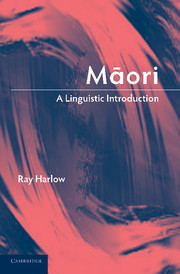Book contents
- Frontmatter
- Contents
- List of figures
- List of maps
- List of tables
- Acknowledgements
- List of abbreviations
- Introduction
- 1 Māori literature and literature on Māori
- 2 A brief history of Māori
- 3 Regional variation in Māori
- 4 The phonology of Māori
- 5 The morphology of Māori
- 6 The syntax of Māori
- 7 The sociolinguistic situation of Māori
- References
- Index
4 - The phonology of Māori
Published online by Cambridge University Press: 28 January 2010
- Frontmatter
- Contents
- List of figures
- List of maps
- List of tables
- Acknowledgements
- List of abbreviations
- Introduction
- 1 Māori literature and literature on Māori
- 2 A brief history of Māori
- 3 Regional variation in Māori
- 4 The phonology of Māori
- 5 The morphology of Māori
- 6 The syntax of Māori
- 7 The sociolinguistic situation of Māori
- References
- Index
Summary
Like most PN languages, Māori has relatively few segmental phonemes, very simple phonotactics, and little in the way of phonological rules apart from the regularities of the phonetic detail of the phonemes. Nonetheless the phonology of Māori has some features which are not without interest and which raise questions of analysis.
What little morphophonemic alternation Māori exhibits, mostly between long and short vowels in processes such as reduplication and passive suffixation, and the literature on these phenomena, is dealt with in chapter 5. Accordingly, this chapter will restrict itself to the treatment of the phoneme inventory, the phonetics of the realisation of these phonemes, stress, and phonotactics. Included in phonotactics is the matter of which prosodic units are relevant to which later rules, and the relationship between such units.
The development of the writing system(s) now used for Māori parallels to quite a degree the growing awareness of the structure of the Māori sound system. An account of this representation of Māori concludes the chapter.
Phoneme Inventory
The Māori system seems to have been relatively conservative, compared with its closest relations, and reflects the phonology of Proto-Central Eastern Polynesian fairly closely. Most dialects of Māori have ten consonant phonemes and five distinct vowel qualities. Sets of contrasting ‘minimal decuplets’ for consonants, and ‘quintuplets’ for vowel qualities are very easy to find.
- Type
- Chapter
- Information
- MaoriA Linguistic Introduction, pp. 62 - 95Publisher: Cambridge University PressPrint publication year: 2007



